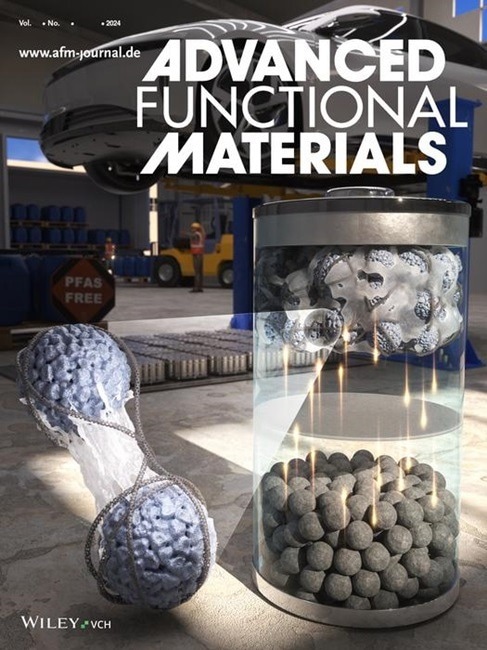Reviewed by Lexie CornerSep 16 2024
Researchers from the Korea Electrotechnology Research Institute (KERI) have developed a technology that utilizes environmentally friendly materials to enhance the performance of binders, often considered the "unsung heroes" of secondary batteries. This innovation was published in the journal Advanced Functional Materials.
 The research results of KERI's 'PVDF Replacement Battery Binder Technology' have been published as the prestigious journal Advanced Functional Materials’ cover article. Image Credit: Korea Electrotechnology Research Institute
The research results of KERI's 'PVDF Replacement Battery Binder Technology' have been published as the prestigious journal Advanced Functional Materials’ cover article. Image Credit: Korea Electrotechnology Research Institute
The research team, led by Dr. Hyeon-Gyun Im and Dr. Dong Jun Kang from the Insulation Materials Research Center of Korea Electrotechnology Research Institute (KERI), collaborated with Dr. Jung-keun Yoo from KIST and Professor Jong-soon Kim from Sungkyunkwan University.
In secondary battery production, the electrode plays the most significant role in performance. Its fabrication involves combining a solvent with an “active material” that generates electricity, a “conductive material” that facilitates energy flow, and a “binder.” The binder's function is to physically stabilize the electrode and ensure good adhesion between the conductive and active materials and the metal plate (current collector).
Historically, binder research progressed more slowly due to their small proportion in the electrode. However, binders are gaining attention with the increasing demand for high-capacity and high-performance batteries. Polyvinylidene Fluoride (PVDF), a fluoropolymer, is commonly used as the binder material for the positive electrodes in lithium-ion batteries.
However, the use of PVDF has been associated with persistent functional problems, such as poor battery stability, and its production is controlled by a few multinational companies in Europe and Japan. PVDF is often referred to as a “zombie compound” due to its nearly indestructible carbon-fluorine (C-F) bonds, which make it highly resistant to decomposition and cause it to persist in the environment for a long time.
Additionally, burning PVDF releases significant amounts of greenhouse gases. Due to these environmental concerns, the European Union (EU) is considering regulations on the use of PVDF, creating an urgent need for better alternatives.
KERI has addressed this issue by developing a positive electrode binder coated with “siloxane,” a silicon-oxygen compound known for its exceptional electrical and chemical stability. After years of research into nanocomposites, the team led by Drs. Hyeon-Gyun Im and Dong Jun Kang created a “hybrid siloxane resin manufacturing technology” that combines the advantages of both organic and inorganic materials.
The KERI team has also developed synthesis control technologies and chemical structure designs tailored for positive electrode binders.
In various validation tests, they applied this technology to produce whole cells. The results showed that the KERI technology offers over 1.4 times the lifespan stability of traditional PVDF-based binders.
While PVDF is known for its strong adhesion, durability, and physical and chemical stability, it faces challenges such as swelling and unwanted material reactions as batteries have advanced toward higher capacity and performance. KERI’s technology has surpassed these limitations.
A key advantage of this new technology is that it is fluorine-free, making it safer for both human health and the environment. This innovation is expected to significantly reduce reliance on imported positive electrode binders while also helping companies comply with upcoming EU regulations aimed at limiting PVDF use.
While Korea’s battery industry is world-class, we currently rely entirely on imports for positive electrode binders due to the lack of specialized technology and companies domestically. Our environmentally friendly binder technology using siloxane has the potential to replace existing PVDF and enhance the safety and lifespan of products requiring high-capacity batteries, such as electric vehicles.
Dr. Hyeon-Gyun Im, Korea Electrotechnology Research Institute
The research team expects significant interest from the secondary battery industry in this achievement and plans to seek potential demand partners for technology transfer. Additionally, they aim to expand the technology's application to other areas, such as zinc and sodium batteries, and adapt it for use in dry positive electrode binder materials.
Journal Reference:
Jang, J., et al. (2024) A Fluorine‐Free Binder with Organic–Inorganic Crosslinked Networks Enabling Structural Stability of Ni‐Rich Layered Cathodes in Lithium‐Ion Batteries. Advanced Functional Materials. doi.org/10.1002/adfm.202410866.